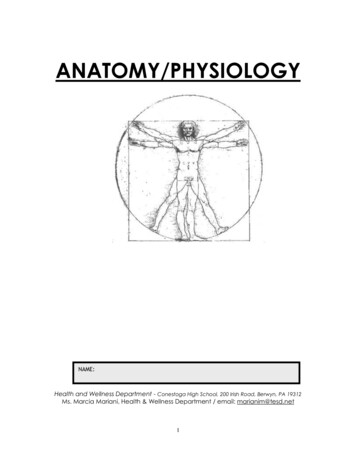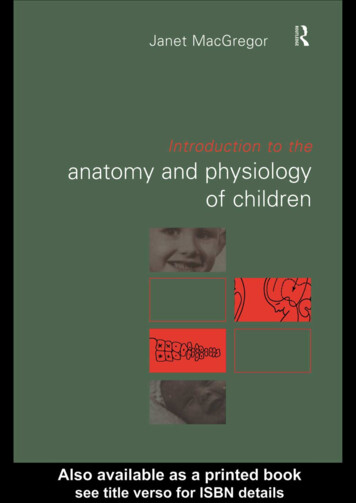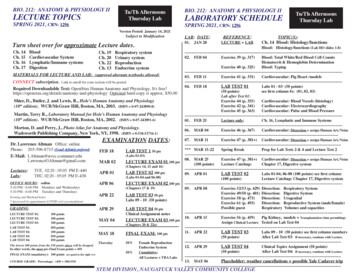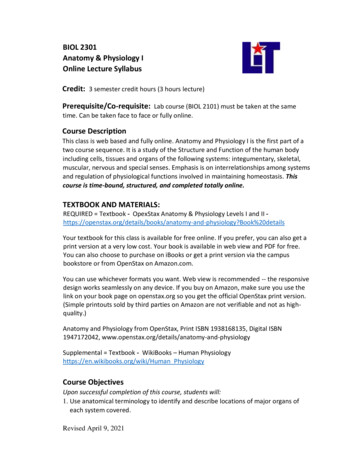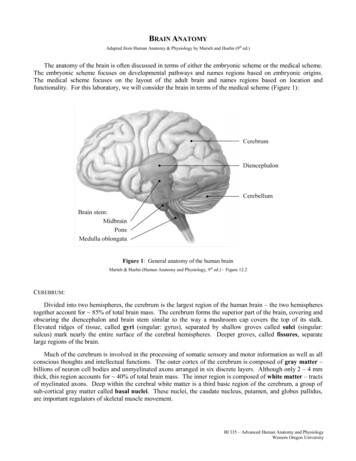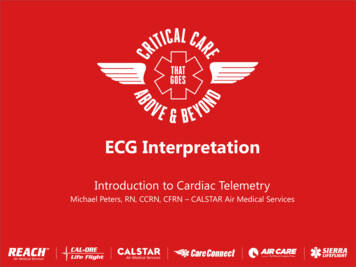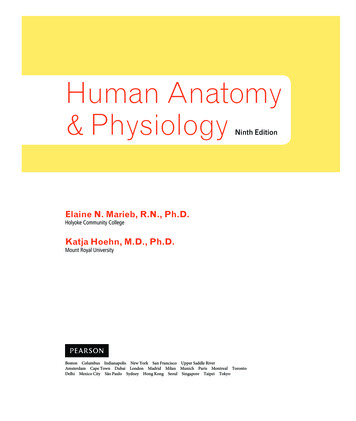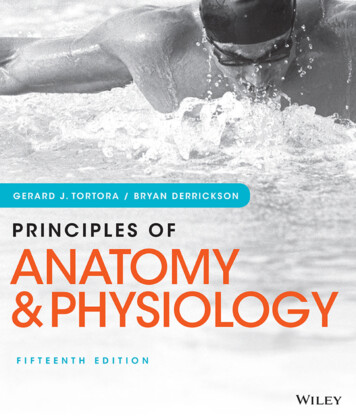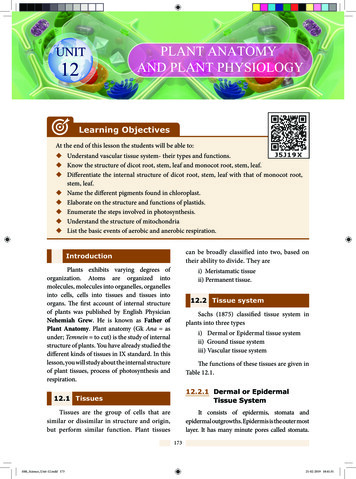
Transcription
PLANT ANATOMYAND PLANT PHYSIOLOGYLearning ObjectivesAt the end of this lesson the students will be able to: Understand vascular tissue system- their types and functions. Know the structure of dicot root, stem, leaf and monocot root, stem, leaf. Differentiate the internal structure of dicot root, stem, leaf with that of monocot root,stem, leaf. Name the different pigments found in chloroplast. Elaborate on the structure and functions of plastids. Enumerate the steps involved in photosynthesis. Understand the structure of mitochondria List the basic events of aerobic and anerobic respiration.can be broadly classified into two, based ontheir ability to divide. They areIntroductionPlants exhibits varying degrees oforganization. Atoms are organized intomolecules, molecules into organelles, organellesinto cells, cells into tissues and tissues intoorgans. The first account of internal structureof plants was published by English PhysicianNehemiah Grew. He is known as Father ofPlant Anatomy. Plant anatomy (Gk Ana asunder; Temnein to cut) is the study of internalstructure of plants. You have already studied thedifferent kinds of tissues in IX standard. In thislesson, you will study about the internal structureof plant tissues, process of photosynthesis andrespiration.i) Meristamatic tissueii) Permanent tissue.12.2 Tissue systemSachs (1875) classified tissue system inplants into three typesi) Dermal or Epidermal tissue systemii) Ground tissue systemiii) Vascular tissue systemThe functions of these tissues are given inTable 12.1.12.2.1 Dermal or EpidermalTissue System12.1 TissuesTissues are the group of cells that aresimilar or dissimilar in structure and origin,but perform similar function. Plant tissuesIt consists of epidermis, stomata andepidermal outgrowths. Epidermis is the outer mostlayer. It has many minute pores called stomata.17310th Science Unit-12.indd 17321-02-2019 18:41:31
Table 12.1 Tissue system and its functionsTissue SystemDermal Tissue SystemGround Tissue SystemVascular Tissue SystemComponentsFuntionsEpidermis and Periderm(in older stems and roots) Protection Prevention of water lossParenchyma tissue Collenchyma tissueSclerenchyma tissuePhotosynthesisFood storageRegenerationSupportProtection Transport of water andminerals Transport of foodVascular tissues- Xylem tissue- Phloem tissueCuticle is present on the outer wall of epidermis tocheck evaporation of water. Trichomes and roothairs are the epidermal outgrowths.(ii) Conjoint bundlesFunctions:a) Collaterali)Xylem lies towards the centre and phloemlies towards the periphery.Xylem and phloem lie on the same radius.There are two types of conjoint bundles.Epidermis protects the inner tissues.ii) Stomata helps in transpiration.When cambium is present in collateralbundles, it is called open. e.g. dicot stem andcollateral bundle without cambium is calledclosed. e.g. monocot stem.iii) Root hairs help in absorption of water andminerals.12.2.2 Ground Tissue SystemIt includes all the tissues of the plantbody except epidermal and vascular tissueslike (i) Cortex (ii) Endodermis (iii) Pericycle(iv) Pithb) Bicollateral12.2.3 Vascular Tissue System(iii) Concentric BundlesIt consists of xylem and phloem tissues.They are present in the form of bundles calledvascular bundles. Xylem conducts water andminarals to different parts of the plant. Phloemconducts food materials to different parts ofthe plant.Vascular bundle in which xylem completelysurrounds the phloem or viceversa is calledconcentric vascular bundle. It is of two types:In this type of bundle, the phloem ispresent on both outer and inner side of xylem.e.g. Cucurbita1. Amphivasal: Xylem surrounds phloem.e.g. Dracaena2. A mphicribral: Phloem surrounds xylem.e.g. FernsThere are three different types of vascularbundles namely (i) Radial (ii) Conjoint(iii) Concentric(i) Radial BundlesEndarch: Protoxylem lies towards the centreand metaxylem lies towards the periphery. e.g.stem.Xylem and phloem are present in differentradii alternating with each other. e.g. rootsExarch : Protoxylem lies towards the peripheryand metaxylem lies towards the centre. e.g. roots.10th Standard Science10th Science Unit-12.indd 17417421-02-2019 18:41:31
PhloemCambiumXylemXylemPhloemRadialConjoint, collateral and openConjoint, collateral and closedOuter PhloemOuter CambiumXylemXylemPhloemInner CambiumInner PhloemConjoint, BicollateralConcentric and AmphicribralConcentric and AmphivasalFigure 12.1 Types of vascular bundle(a) Pericycle: Inner to endodermis lies asingle layer of pericycle. It is the site of originof lateral roots.12.3 Internal Structure ofDicot Root (Bean)A thin transverse section of dicot rootshows the following structures.(b) Vascular bundle: It is radial.Xylem is exarch and tetrach. The tissuepresent between xylem and phloem is calledconjunctive tissue. In dicot root, it is made upof parenchyma.(i) Epiblema: It is the outermost layer.Cuticle and stomata are absent. Unicellularroot hairs are present. It is also known asRhizodermis or Piliferous layer.(c) Pith: Young root contains pith whereasin old root pith is absent.(ii) Cortex: It is a multilayered large zonemade of thin-walled parenchymatous cellswith intercellular spaces. It stores food andwater.12.4 Internal Structure ofMonocot Root (Maize)(iii) Endodermis: It is the innermost layerof cortex. The cells are barrel - shaped, closelypacked, and show band like thickenings ontheir radial and inner tangential walls calledcasparian strips. It helps in the movement ofwater and dissolved salts from cortex into xylem.A thin transverse section of monocotroot, shows the following characteristicfeatures.i. Epiblema or Rhizodermis: It is theoutermost layer of the root, and is made upof single layer of thin walled, parenchymatouscell. Stomata and cuticle are absent. The roothair helps in absorption of water and minerals(iv) Stele: All tissues inner to endodermisconstitute stele. It includes pericycle andvascular bundle.17510th Science Unit-12.indd 175Plant Anatomy and Plant Physiology21-02-2019 18:41:31
Root hairPiliferous layerCortexRoot hairPiliferous layerCortexPhloemEndodermisXylemPithGround planGround planRoot hairRoot hairPiliferous layerPiliferous layerCortexCortexEndodermisPhloemCasparian asparian stripPithA sector enlargedA sector enlargedFigure 12.2 Transverse section of Dicot rootFigure 12.3 Transverse section ofMonocot rootfrom the soil. This layer also protects the innertissues.c) Pith: It is present at the center. It is made upof parenchyma cells with intercellular spaces.It contains abundant amount of starch grains.It stores food.ii. Cortex: It is multilayered large zone,composed of parenchymatous cells withintercellular spaces. It stores water and foodmaterial.iii. Endodermis: It is the innermost layerof cortex with characteristic casparian stripsand passage cells. Casparian strips are bandlike thickening made of suberin.12.5 Internal Structure of DicotStem (Sunflower)The transverse section of a dicot stemreveals the following structures.iv. Stele: All the tissues inner toendodermis constitute stele. It includespericycle, vascular tissues and pith.a) Pericycle: It is a single layer of thin walledcells. The lateral roots originate from this layer.b) Vascular tissues: It consists of many patchesof xylem and phloem arranged radially. Thexylem is exarch and polyarch. The conjunctivetissue is made up of sclerenchyma.10th Standard Science10th Science Unit-12.indd 1761. Epidermis: It is the outermost layer. It ismade up of single layer of parenchymacells, its outer wall is covered with cuticle.It is protective in function.2. Cortex:- It is divided into three regions:(i) Hypodermis: It consists of 3 - 6 layersof collenchyma cells. It gives mechanicalsupport.17621-02-2019 18:41:31
Table 12.2 Differences between Dicot and Monocot rootS. No. TissuesDicot RootMonocot Root1Number of XylemTetrarchPolyarch2CambiumPresent(During secondarygrowth only)Absent3Secondary GrowthPresentAbsent4PithAbsentPresentcells. It is covered with thick cuticle.Multicellular hairs are absent and stomataare also less in number.(ii) Middle cortex: It is made up of fewlayers of chlorenchyma cells. It is involedin photosynthesis due to the presence ofchloroplast.2. Hypodermis: It is made up of few layersof sclerenchyma cells interrupted bychlorenchyma. Sclerenchyma providesmechanical support to plant.(iii) Inner cortex: It is made up of fewlayers of parenchyma cells. It helps in gaseousexchange and stores food materials.3. Ground tissue: The entire mass ofparenchyma cells next to hypodermisEndodermis is the inner most layer ofcortex it consists of a single layer of barrelshaped cells, these cells contain starch grains.So it is also called starch sheath.Epidermal hairEpidermisHypodermisCortexEndodermis3. Stele: The central part of the stem inner toendodermis is known as stele. It consists ofpericycle, vascular bundle and pith.(i) Pericycle: It occurs between vascularbundle and endodermis. It is multilayered,parenchymatous with alternating patches ofsclerenchyma.Vascular bundlePithGround planEpidermal hairCuticle(ii) Vascular bundle: Vascular bundlesare conjoint, collateral, endarch and open.They are arranged in the form of a ring aroundthe i) Pith: The large central parenchymatouszone with intercellular spaces is called pith. Ithelps in the storage of food materials.EndodermisPhloemCambium12.6 Internal Structure ofMonocot Stem (Maize)XylemPithA transverse section of monocot stemreveals the following structures.A sector enlarged1. Epidermis: It is the outermost layer. It ismade up of single layer of parenchymaFigure 12.4 Transverse section of Dicot stem17710th Science Unit-12.indd 177Plant Anatomy and Plant Physiology21-02-2019 18:41:32
and extending to the centre is calledground tissue. It is not differentiated intoendodermis, cortex, pericycle and pith.EpidermisGround tissueVascular bundles4. Vascular Bundle: Vascular bundles are skullshaped and scattered in the ground tissue.Vascular bundles are conjoint, collateral,endarch and closed. Each vascular bundleis surrounded by few layer of sclerenchymacells called bundle sheath.Ground planCuticleEpidermisHypodermisChlorenchyma(a) Xylem: It consists of metaxylem andprotoxylem. Xylem vessels are arrangedin V or Y shape. In mature vascularbundle, the lower most protoxylemdisintegrates and form a cavity. This iscalled protoxylem lacuna.Vascular bundlesGround tissuePhloemMetaxylemProtoxylem(b) Phloem: It consists of sieve tubeelements and companion cells. Phloemparenchyma, and phloem fibers areabsent.Bundle sheathA sector enlarged5. Pith: Pith is not differentiated in monocotstems.Figure 12.5 Transverse section ofMonocot stemTable 12.3 Differences between Dicot and Monocot StemS. No. Tissues1Hypodermis2Ground tissueDicot StemMonocot StemCollenchymatousDifferentiated into cortex,endodermis, pericycle and pith(i) Less in number(ii) Uniform in sizeSclerenchymatousUndifferentiated3Vascular bundles4Secondary growthPresent(i) Numerous(ii) Smaller near periphery, biggerin the centre(iii) Scattered(iv) Closed(v) Bundle sheath presentMostly absent5PithPresentAbsent6Medullary raysPresentAbsent(iii) Arranged in a ring(iv) Open(v) Bundle sheath absent(i) Upper epidermis: This is the outermost layermade of single layered parenchymatouscells without intercellular spaces. The outerwall of the cells are cuticularized. Stomataare less in number.12.7 Internal Structure ofDicot or Dorsiventral Leaf(Mango)The transverse section of leaf shows thefollowing structures.10th Standard Science10th Science Unit-12.indd 17817821-02-2019 18:41:32
CuticleUpper epidermisPalisade parenchymaXylemSpongy parenchymaPhloemBundle sheathStomaEpidermal hairLower epidermisFigure 12.6 Transverse section of Dicot leafbundle sheath. Each vascular bundleconsists of xylem lying towards theupper epidermis and phloem towardsthe lower epidermis.(ii) Lower epidermis: It is a single layer ofparenchymatous cells with a thin cuticle. Itcontains numerous stomata. Chloroplastsare present only in guard cells. The lowerepidermis helps in the exchange of gases.The loss of water vapour is facilitatedthrough this chamber.12.8 Internal Structure ofMonocot or IsobilateralLeaf(iii) Mesophyll: The tissue present betweenthe upper and lower epidermis is calledmesophyll. It is differentiated into Palisadeparenchyma and Spongy parenchyma.The transverse section of a monocot leafreveals the following structures.(i)a) Palisade parenchyma: It is found justbelow the upper epidermis. The cellsare elongated. These cells have morenumber of chloroplasts. The cells donot have intercellular spaces and theytake part in photosynthesis.b) Spongy parenchyma: It is foundbelow the palisade parenchymatissue. Cells are almost spherical oroval and are irregularly arranged.Cells have intercellular spaces. Ithelps in gaseous exchange.(ii) Mesophyll: It is the ground tissue that ispresent between both epidermal layers.Mesophyll is not differentiated intopalisade and spongy parenchyma. The cellsare irregularly arranged with inter-cellularspaces. These cells contain chloroplasts.(iv) Vascular bundles: Vascular bundle ofmid-rib is larger. Vascular bundles areconjoint, collateral and closed. Eachvascular bundle is surrounded by asheath of parenchymatous cells called(iii) Vascular bundles: Large number ofvascular bundles are present, some ofwhich are small and some are large.Each vascular bundle is surrounded byparenchymatous bundle sheath. Vascular17910th Science Unit-12.indd 179Epidermis: Monocot leaf has upper andlower epidermis. Epidermis is made upof parenchyma cells. Cuticle is present onthe outer wall stomata are present on bothupper and lower epidermis. Some cells ofupper epidermis are large and thin walledthey are known as bulliform cells.Plant Anatomy and Plant Physiology21-02-2019 18:41:32
CuticleBulliform cellsUpper epidermisMesophyllBundle sheathXylemPhloemLower epidermisStomaFigure 12.7 Transverse section of Monocot Leafbundles are conjoint, collateral and closed.Xylem is present towards upper epidermisand phloem towards lower epidermis.of 2-10 micrometer and a thickness of 1-2micrometer.Thylakoid membraneThylakoid lumenDrop of lipidsTable 12.4 Differences between of Dicot andMonocot LeafS. No.Dicot LeafChloroplastDNAStarch granuleMonocot Leaf1Dorsiventral leafIsobilateral leaf2Mesophyll isdifferentiatedinto palisadeand spongyparenchymaMesophyll is notdifferentiatedinto palisadeand spongyparenchymaRibosomeGranumStroma lamellaInner membraneIntermembrane spaceOuter membrane1. Envelope: Chloroplast envelope has outerand inner membranes which is seperatedby intermembrane space.2. Stroma: Matrix present inside to themembrane is called stroma. It containsDNA, 70 S ribosomes and other moleculesrequired for protein synthesis.3. Thylakoids: It consists of thylakoidmembrane that encloses thylakoid lumen.Thylakoids forms a stack of disc likestructures called a grana (singular-granum).Plastids are double membrane boundorganelles found in plants and some algae. Theyare responsible for preparation and storage offood. There are three types of plastids.4. Grana: Some of the thylakoids are arrangedin the form of discs stacked one above theother. These stacks are termed as grana,they are interconnected to each other bymembranous lamellae called Fret channels.Chloroplast - green coloured plastidsChromoplast - yellow, red, orange colouredplastids- colourless plastidsLeucoplast12.9.2 Functions of Chloroplast12.9.1 Structure of Chloroplast1. Photosynthesis 2. Storage of starch3. Synthesis of fatty acids 4. Storage of lipids5. Formation of chloroplastsChloroplasts are green plastids containinggreen pigment called chlorophyll. Chloroplastsare oval shaped organelles having a diameter10th Science Unit-12.indd 180ThylakoidFigure 12.8 Ultrastructure of Chloroplast12.9 Plastids10th Standard ScienceStroma18021-02-2019 18:41:33
12.9.3 Photosynthesischloroplast is such that the light dependent(Light reaction) and light independent (Darkreaction) take place at different sites in theorganellePhotosynthesis (Photo light; synthesis tobuild) is a process by whichautotrophic organisms likegreen plants, algae andchlorophyllcontainingbacteria utilize the energy from sunlight tosynthesize their own food. In this process,carbon dioxide combines with water in thepresence of sunlight and chlorophyll to formcarbohydrates. During this process oxygen isreleased as a byproduct.6CO 12H OCarbon dioxide WaterLightchlorophyll1. Light dependent photosynthesis (Hillreaction \ Light reaction)This was discovered by Robin Hill (1939).This reaction takes place in the presence oflight energy in thylakoid membranes (grana)of the chloroplasts. Photosynthetic pigmentsabsorb the light energy and convert it intochemical energy ATP and NADPH2. Theseproducts of light reaction move out from thethylakoid to the stroma of the chloroplast.C6H12O6 6 H O 6O More to KnowGlucose Water Oxygen12.9.4 Where doesphotosynthesis occur?Photosynthesis occurs in green parts ofthe plant such as leaves, stems and floral buds.ATPAdenosine TriphosphateADPAdenosine DiphosphateNADNicotinamide AdenineDinucleotideNADPNicotinamide AdenineDinucleotide Phosphate12.9.5 Photosynthetic PigmentsPigments involved in photosynthesisarecalledPhotosynthetic pigments.Photosynthetic pigments are of two classesnamely, the primary pigments and accessorypigments. Chlorophyll a is the primarypigment that traps solar energy and convertsit into electrical and chemical energy. Thus itis called the reaction centre. Other pigmentssuch as chlorophyll b and carotenoids arecalled accessory pigments as they pass onthe absorbed energy to chlorophyll a (Chl.a)molecule. Reaction centres (Chl. a) andthe accessory pigments (harvesting centre)together are called photosystems.A cell cannot get its energydirectly from glucose. Soin respiration the energyreleased from glucose is used to make ATP(Adenosine Triphosphate)2. Light independent reactions(Biosynthetic phase)The second steps (dark reaction orbiosynthetic pathway) is carried out in thestroma. During this reaction CO2 is reducedinto carbohydrates with the help of lightgenerated ATP and NADPH2. This is alsocalled as Calvin cycle and is carried out in theabsence of light.12.9.6 Role of Sunlight inPhotosynthesisIn Calvin cycle the inputs are CO2 fromthe atmosphere and the ATP and NADPH2produced from light reaction.The entire process of photosynthesis takesplace inside the chloroplast. The structure of18110th Science Unit-12.indd 181Plant Anatomy and Plant Physiology21-02-2019 18:41:33
12.10 MitochondriaMitochondria are filamentous orgranular cytoplasmic organelles present incells. The mitochondria were first discoveredby Kolliker in 1857 as granular structures instriated muscles. Mitochondria (singular:mitochondrion) are organelles withineukaryotic cells that produce adenosinetriphosphate (ATP) which form the energycurrency of the cell, for this reason, themitochondria is referred to as the “Powerhouse of the cell”. Mitochondria vary in sizefrom 0.5 µm to 2.0 µm. Mitochondria contain60-70% protein, 25-30% lipids, 5-7% RNA andsmall amount of DNA and minerals.Figure 12.9 Overview of Hill andCalvin cycleMelvin Calvin, an Americanbiochemist,discoveredchemical pathway forphotosynthesis. The cycle isnamed as Calvin cycle. Hewas awarded with NobelPrize in the year 1961 for his discovery.12.10.1 Structure of MitochondriaMitochondrial Membranes: It consiststwo membranes called inner and outermembrane. Each membrane is 60-70 A thick.Outer mitochondrial membrane is smoothand freely permeable to most small molecules.It contains enzymes, proteins and lipids. Ithas porin molecules (proteins) which formchannels for passage of molecules through it.12.9.7 Factors AffectingPhotosynthesisa) Internal Factors:i) Pigments ii) Leaf age iii) Accumulation ofcarbohydrates iv) HormonesInner mitochondrial membrane is semipermeable membrane and regulates the passageof materials into and out of the mitochondria.It is rich in enzymes and carrier proteins. Itconsists of 80% proteins and lipids.b) External Factors:i) Light ii) Carbon dioxide iii) Temperatureiv) Water v) Mineral elementsInfo bitArtificialphotosynthesisis a method for producingrenewable energy by the useof sunlight. Indian scientistC.N.R. Rao who wasconferred the Bharat Ratna(2013) is also working on similar technologyof artificial photosynthesis to produce Hydrogen fuel (renewable energy).10th Standard Science10th Science Unit-12.indd 182Figure 12.10 Structure of Mitochondria18221-02-2019 18:41:33
Cristae: The inner mitochondrialmembrane gives rise to finger like projectionscalled cristae. These cristae increase the innersurface area (fold in inner membrane) of themitochondria to hold variety of enzymes.cells where the food is oxidized to obtainenergy, this is known as cellular respirationOxysomes: The inner mitochondrialmembrane bear minute regularly spaced tennisracket shaped particles known as oxysomes(F1 particle). They involve in ATP synthesis.12.11.1 Aerobic respirationF1Aerobic respiration is the type of celluarrespiration in which organic food is completelyoxidized with the help of oxygen into carbondioxide, water and energy. It occurs in mostplants and animals.StalkC6H12O6 6O2 6CO2 6H2O ATPFigure 12.11 Structure of OxysomesStages of Aerobic respirationMitochondrial matrix - It is a complexmixture of proteins and lipids. Matrix containsenzymes for Krebs cycle, mitochondrialribosomes(70 S), tRNAs and mitochondrialDNA.a. Glycolysis (Glucose splitting): It isthe breakdown of one molecule of glucose(6 carbon) into two molecules of pyruvic acid(3 carbon). Glycolysis takes place in cytoplasmof the cell. It is the first step of both aerobic andanerobic respiration.12.10.2 Functions of Mitochondria b. Krebs Cycle: This cycle occurs inmitochondria matrix. At the end of glycolysis,2 molecules of pyruvic acid enter intomitochondria. The oxidation of pyruvic acidinto CO2 and water takes place through thiscycle. It is also called Tricarboxylic Acid Cycle(TCA).Mitochondria is the main organelle of cellrespiration. They produce a large numberof ATP molecules. So they are called aspower houses of the cell or ATP factoryof the cell.It helps the cells to maintain normalconcentration of calcium ions.It regulates the metabolic activity of the cell.c. Electron Transport Chain: This isaccomplished through a system of electroncarrier complex called electron transportchain (ETC) located on the inner membraneof the mitochondria. NADH2 and FADH2molecules formed during glycolysis and Krebscycle are oxidised to NAD and FAD to releasethe energy via electrons. The electrons, as theymove through the system, release energy whichis trapped by ADP to synthesize ATP. Thisis called oxidative phosphorylation. In this12.11 TYPES OF RESPIRATIONRespiration involves exchange of gasesbetween the organism and the externalenvironment. The plants obtain oxygen fromtheir environment and release carbon dioxideand water vapour. This exchange of gases isknown as external respiration. It is a physicalprocess. Biochemical process occurs within18310th Science Unit-12.indd 183Plant Anatomy and Plant Physiology21-02-2019 18:41:33
process, O2 the ultimate acceptor of electronsgets reduced to water.Points to Remember Tissue is a group of similar or dissimilarcells, having a common orgin andperforming similar functions.12.11.2 Anaerobic respirationAnaerobic respiration takes place withoutoxygen. Glucose is converted into ethanol (inplants) or lactate (in some bacteria) Plants are capable of synthesizing glucosefrom CO2 and H2O in the presence of light,by the process of photosynthesis.C6H12O6 2CO2 2C2H5OH Energy (ATP) Light reaction takes place in grana ofchloroplast.12.11.3 Respiratory quotient(R.Q) Dark reaction takes place in stroma ofchloroplast. Respiration involves both external andcellular respiration.Respiratory quotient is the ratio of volumeof carbon dioxide liberated and the volumeof oxygen consumed during respiration. It isexpressed asRQ Aerobic respiration takes place in thepresence of oxygen. Aerobic respiration occurs in three majorsteps like Glycolysis, Krebs cycle andElectron transport chain.Volume of CO2 liberatedVolume of O2 consumedTEXTBOOK EVALUATIONI. Choose the correct answer5. Kreb’s cycle takes place in1. Casparian strips are present in theof the root.a) cortexc) pericyclea)b)c)d)b) pithd) endodermis2. The endarch condition is the characteristicfeature ofa) rootc) leaves6. Oxygen is produced at what point duringphotosynthesis ?b) stemd) flowera)b)c)d)3. The xylem and phloem arranged side byside on same radius is calleda) radialc) conjoint4. Which isrespirationb) amphivasald) None of theseformeda) Carbohydrateb) Acetyl CoA10th Standard Science10th Science Unit-12.indd 184duringchloroplastmitochondrial matrixstomatainner mitochondrial membranewhen ATP is converted to ADPwhen CO2 is fixedwhen H2O is splittedAll of theseII. Fill in the blanks.1. Cortex lies between .2. Xylem and phloem occurring on the sameradius constitute a vascular bundle called.anaerobicb) Ethyl alcohold) Pyruvate3. Glycolysis takes place in .18421-02-2019 18:41:33
4. The source of O2 liberated in photosynthesisis .7.5. is ATP factory of the cells8.III. State whether the statements are true orfalse. Correct the false statement.1. Phloem tissue is involved in the transportof water in plant.2. The waxy protective covering of a plant iscalled as cuticle.3. In monocot stem cambium is present inbetween xylem and phloem.4. Palisade parenchyma cells occur belowupper epidermis in dicot root.5. Mesophyll contains chlorophyll.6. Anaerobic respiration produces more ATPthan aerobic respiration.VII. Long answer questions1. Differentiate the followinga) Monocot root and Dicot rootb) Aerobic and Anaerobic -DracaenaTranslocation of foodFernSecondary growthConduction of waterV. Answer in a sentence1. What is collateral vascular bundle?2. Where does the carbon that is used inphotosynthesis come from?3. What is the common step in aerobic andanaerobic pathway?4. Name the phenomenon by whichcarbohydrates are oxidized to release ethylalcohol.Describe and name three stages of cellularrespiration that aerobic organisms use toobtain energy from glucose.3.How does the light dependent reactiondiffer from the light independent reaction?What are the end product and reactantsin each? Where does each reaction occurwithin the chloroplast?REFERENCE BOOKS1.VI. Short answer questions1. Give an account on vascular bundle ofdicot stem.2. Write a short note on mesophyll.3. Draw and label the structure of oxysomes.4. Name the three basic tissues system inflowering plants.5. What is photosynthesis and where in acell does it occur?6. What is respiratory quotient?2.3.Bajracharya D, Experiments in PlantPhysiology, Narosa Publishing House,New DelhiPandey B.P. Plant Anatomy, S. Chand andCompany Ltd, New DelhiVerma P.S. and Agarwal V.K. Cytology,S.Chand and Company Ltd, New DelhiI NT ER NET R ES OURCESwww.science daily.comwww.britannica.com18510th Science Unit-12.indd 1852.VIII. Higher Order Thinking Skills(HOTS)1. The reactions of photosynthesis make up abiochemical pathway.A) What are the reactants and productsfor both light and dark reactions.B) Explain how the biochemical pathwayof photosynthesis recycles many of itsown reactions and identify the recycledreactants.2. Where do the light dependent reaction andthe Calvin cycle occur in the chloroplast?IV. Match the following1.2.3.4.5.Why should the light dependent reactionoccur before the light independent reaction?Write the reaction for photosynthesis?Plant Anatomy and Plant Physiology21-02-2019 18:41:33
Concept endentreactionKrebscycleRespirationLivingworld atomyMonocotroot,stem,leavesDicot root,stem, leavesVascularsystemPLANT ANATOMYICT CORNERPHOTOSYNTHESIS – This applicationenables students to play a game to adjustsunlight rays to reach the plant. StepsAccess the application Photoshinythesis with the help of the provided URL or QR code. Install inyour device. After opening the app, Click LEVELS to begin the game. A palnt sapling will be in one side, and sun rays will be at the other side. You have to drag and adjustthe mirror so that the sunlight rays will fall on the plant. At the top left, there is a indicator to show the timings. Explore and complete the other levels gradually.Step1Step2Step3Step4Cells aliveURL : https://play.google.com/store/apps/details?id com.Rinekso.PhotoSHinythesis*Pictures are indicative only10th Standard Science10th Science Unit-12.indd 18618621-02-2019 18:41:35
Plant Anatomy. Plant anatomy (Gk . Ana as under; Temnein to cut) is the study of internal structure of plants. You have already studied the different kinds of tissues in IX standard. In this lesson, you will study about the internal structure of plant tissues

